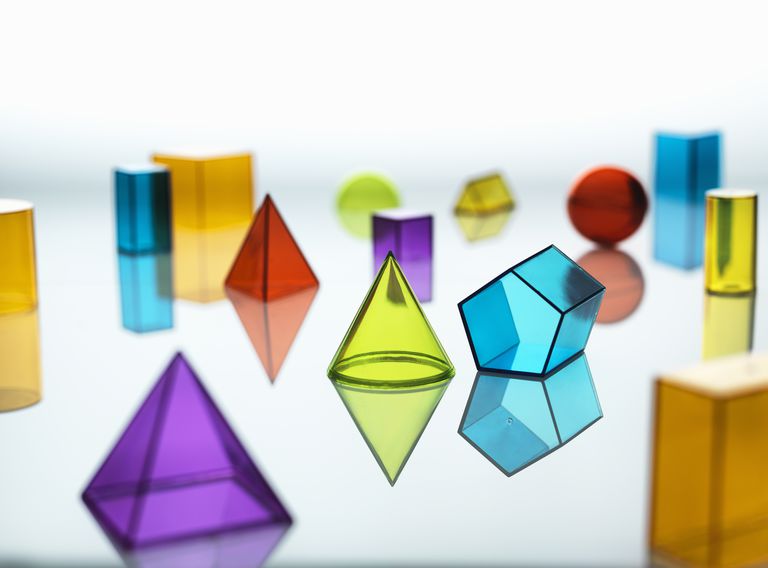Geometrical Shapes and Measurements

Geometry is one of the most important branches of Mathematics. With the help of geometry, we have known and understood different types of shapes in our daily life. Points, lines and angles are the basics of geometry, that are used to construct different figures.
Basically, there are two types of geometrical shapes, two-dimensional and three-dimensional, based on dimensions. The study of these geometric shapes based on different axioms and postulates is called Euclidean Geometry. But, still some of the axioms and postulates were not justified for many shapes and figures. Hence, the Euclid geometry is mostly considered in the field of architecture, constructions, etc.
Two-Dimensional Shapes
The two-dimensional shapes or 2d shapes are defined by their dimensions, in XY plane. The names of 2d shapes are Circle, Square, Triangle, Rectangle, Pentagon, Hexagon, etc.
Circle: A circle is a curved shape that has a fixed radius, from the center of the circle to the outer boundary. The length of the boundary of a circle is called its circumference.
Circumference/Perimeter = 2 Pi (radius)
Area = Pi (radius)2
Triangle: It is a three-sided closed polygon that has three vertices. Sum of all the angles of a triangle is equal to 180 degrees. The total length of the outer boundary of the triangle is called its perimeter.
Perimeter = Sum of three sides
Area = ½ x Base x Height
Square: A square is a four-sided polygon, that has all its sides equal. Therefore, the perimeter of the square is 4 times of its sides and area is equal to side2. Also, all its angles are equal to 90 degrees.
Perimeter = 4(side)
Area = Side2
Rectangle: It is also a four sided polygon, which has its opposite sides equal in length and all the four angles are equal to 90 degrees.
Perimeter = 2 (Length + Breadth)
Area = Length x Breadth
Polygon: A polygon is closed 2d shape, made up of sides and angles. The term “poly” means many. There are no curves in polygon. The types of polygons are: Triangle, Quadrilateral, Pentagon, Hexagon, etc., based on the number of sides and angles.
Three-Dimensional Shapes
The basic three dimensional shapes are:
- Sphere
- Cube
- Cuboid
- Cone
- Cylinder
These solids are defined by two major properties, surface area and volume.
- Surface area is the area covered by the whole surface of a 3d shape
- Volume is the measure of capacity or the space occupied by a 3d shape
Let us see formulas for measurement of surface area and volume of 3d figures.
Sphere: A sphere is a round shape in a 3d plane, that extends in three-dimensions, such as X,Y and Z-axis. For example, a ball, planets, globe, etc. are spherical in shape.
Surface area = 4 pi (radius)2
Volume = 4/3 pi (radius)3
Cube: A cube has 6 faces, 8 vertices and 12 edges and the shape of its faces are in square shape. Similar to 2d shapes, the perimeter of cube is equal to the sum of all its edges.
Surface area = 6 (Edge)2
Volume = Edge3
Cuboid: A cuboid, similar to cube, has 6 faces, 8 vertices and 12 edges. But, the faces of cuboids are in rectangular shape. We can determine the perimeter of cuboid by formula:
Perimeter: 4 (length + breadth + height)
Surface area = 2 (Length x Breadth+breadth x height + Length x height)
Volume = (length × breadth × height)
Cone: A cone is a solid shape that has a circular base. The surface of the cone smoothly narrows from bottom to top at a point, called vertex.
Surface area = pi (radius) (slant height + radius)
Volume = ⅓ pi (radius2) (height)
Cylinder: A cylinder is a solid shape, that has two parallel circular bases at top and bottom, connected by a curved surface.
Surface area = 2 Pi radius (radius + height)
Volume of cylinder = pi (radius2) (height of cylinder)
Conclusion
The area and perimeter are the properties, defined for two-dimensional shapes, since they do not have volume. Whereas surface area and volume are defined for three dimensional solids. There are other properties also, that differentiate 2d shapes with 3d shapes.
The measurement of shapes based on their area, perimeter, surface area and volume, help us to demonstrate the properties of different shapes and also to determine the kind of shapes we see in our day to day lives.










